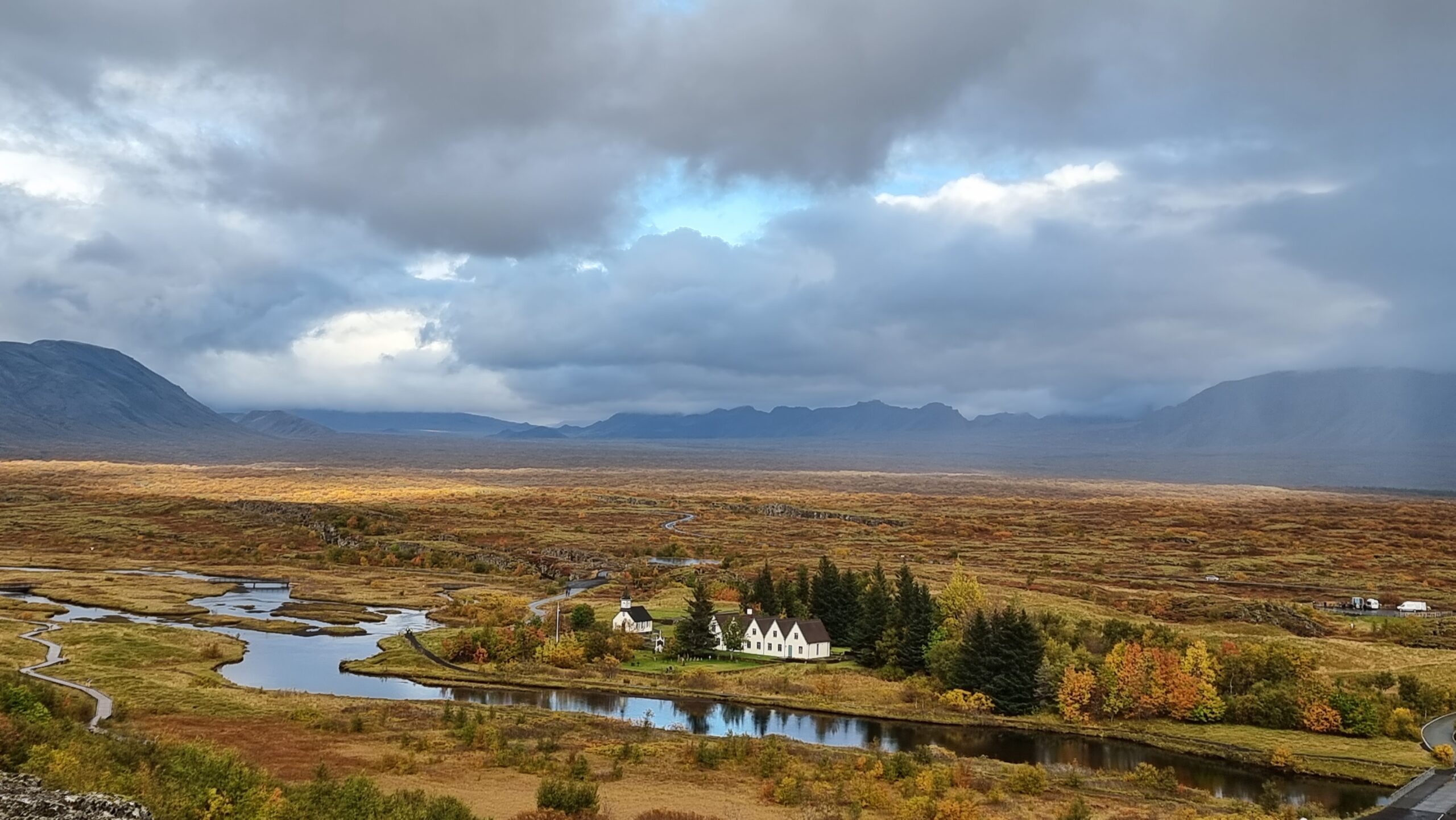One of the must-dos when travelling to Iceland for the first time is the Golden Circle, Gullni hringurinn in Icelandic. Even though the name is just a tourist tag, it does combine some of Iceland’s most famous landmarks and some historical places which will give you a taste of what Iceland has to offer.
How to get there
The Golden Circle is just a short drive East of Reykjavík, so the easiest (and best) way to experience it is to rent a car and drive, while enjoying the beautiful scenery. My first time in Iceland I went in December, and even though the roads were clear of snow, the roads were icy and slippery at points, so still best to get a 4WD if you’re travelling in winter. Bear in mind that days can be very short that time of year: while we were there, the sun rose at 11am and set around 3.30pm, which didn’t leave us much daylight to explore the sights. It is a good idea to break up your Golden Circle trip over 2 days if you have the time, this way you can spend more time in Þingvellir (read Thingvetlir), which has enough things to do to keep you busy an entire day.
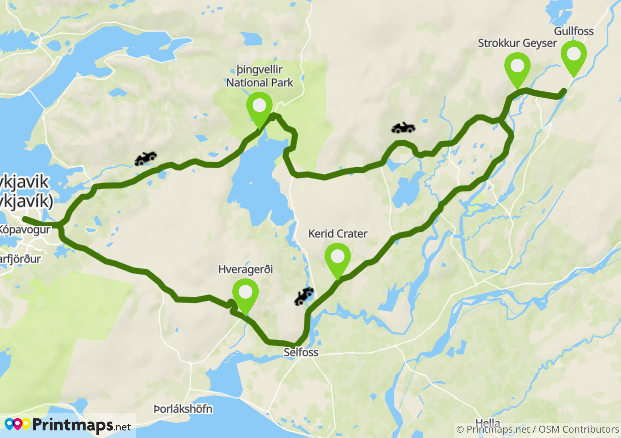
If you don’t want to hire a car, maybe because you’re just staying in Reykjavík for a long weekend, or maybe you don’t feel comfortable driving, there are innumerable day-trip tours departing from Reykjavík, my favourite being this tour which even includes snorkeling in Þingvellir. Or if you’re not interested in snorkeling or if you’re on a budget, this is the cheaper version of the same tour.
Things to see and do
The Golden Circle gained its name from the name of the waterfall Gullfoss, where “gull” stands for gold in Icelandic, and boasts 3 of the major attractions in Iceland: Þingvellir National Park, Geysir and Gullfoss waterfall. Together, these can give you a really good idea of Icelandic nature, and of why it is often called the land of fire and ice. On the way back from seeing these three major landmarks, you can make a couple more stops, including a little detour to enjoy soaking in a geothermal pool.
Þingvellir NATIONAL PARK
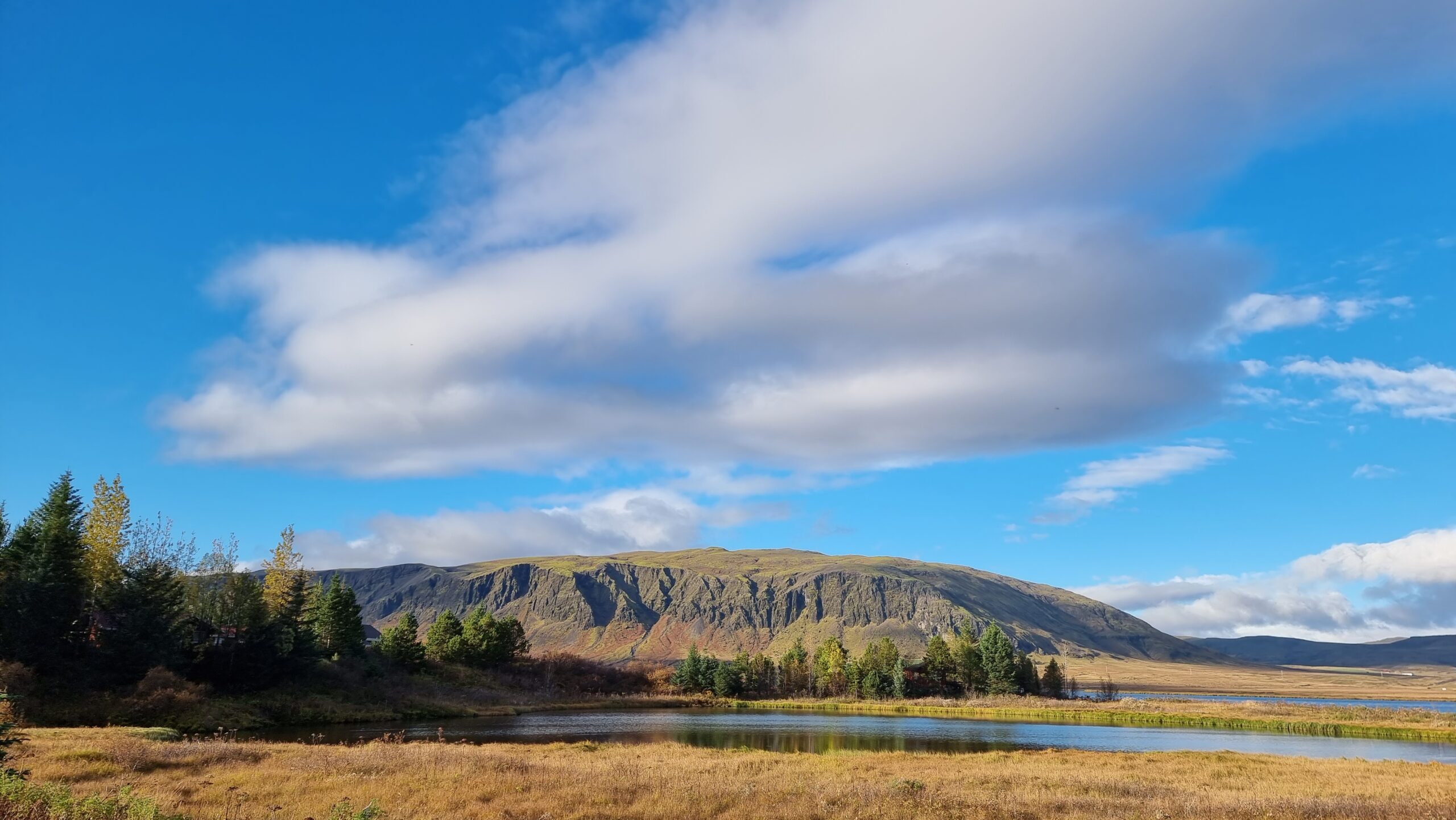
Þingvellir National Park was established in 1930 and became a UNESCO site in 2004. Today it is one of the most visited sites in Iceland, due to its history and beautiful scenery. In fact, Þingvellir is where the Icelandic parliament used to gather, and to this day government meeting still happen on this site. Þingvellir isalso famous because once you could touch both the Eurasian and American tectonic plates at the same time, but these drift further away by 2cm each year, so it’s no longer possible. However, it’s probably still the close you’ll get to being in 2 continents at once.
There’s plenty to do in the park. You can hike along the many walkable trails, you can snorkle (or deep dive if you have a PADI licence), and you can even get a licence to fish in Þingavallavatn (Þingvellir lake). It really depends on how much time you want to spend here.
When we visited, we allocated the entire day to visiting the park.
There are many trails, but we decided to go on a longer adventure and prepared some packed lunch for a little picnic before going snorkeling in Silfra.
If you’re short on time, you can enjoy a nice stroll on the trail leading to Öxaráfoss. On this trail you’ll walk along the Almannagjá, a large 7km rift that marks the eastern boundary of the American tectonic plate, pass the Lögberg, which is where laws where recited in open air in the old days, look over the remains of shelters used at the time of the old assembly session, and finally arrive to the showstopper of the trail, the waterfall Öxaráfoss. Basalt rock formations create this spectacular 13m high waterfall, thought to have been diverted from a different location in ancient times.
From here, you can turn back and head towards the little Þingvellir Church, perfect spot for some final pictures.
We had to wait for our Silfra tour, so we kept on going and walked a bigger loop that took us through beautiful tundra and fissures of crystal clear waters.
If you have enough time, it is definitely worth trying this experience, where you get to snorkle (or dive) between the two tectonic plates in icy cold water. Don’t worry, you’ll be equipped with thermal drysuits, which means only your face and hands will actually get cold. It is a truly unforgettable experience. We chose this tour with Troll Expeditions, which also included photos.
GEYSIR GEOTHERMAL AREA
Next stop on the Golden Circle is the place that gave the name to what we call geysers. The one called Geysir is actually dormant now, so the star of the area is another geyser called Strakkur. This sends jets of hot water high up in the air every 10-15 minutes, so there’s no risk of missing it.
It is very easy to navigate the area thanks to many clearly marked paths, with trails teking you around various fumaroles and pools, all the way to the main attraction Strokkur, which regularly sends jets of water metres high in the air and to Geysir, which is dormant and fenced off at the moment, but still worth visiting.
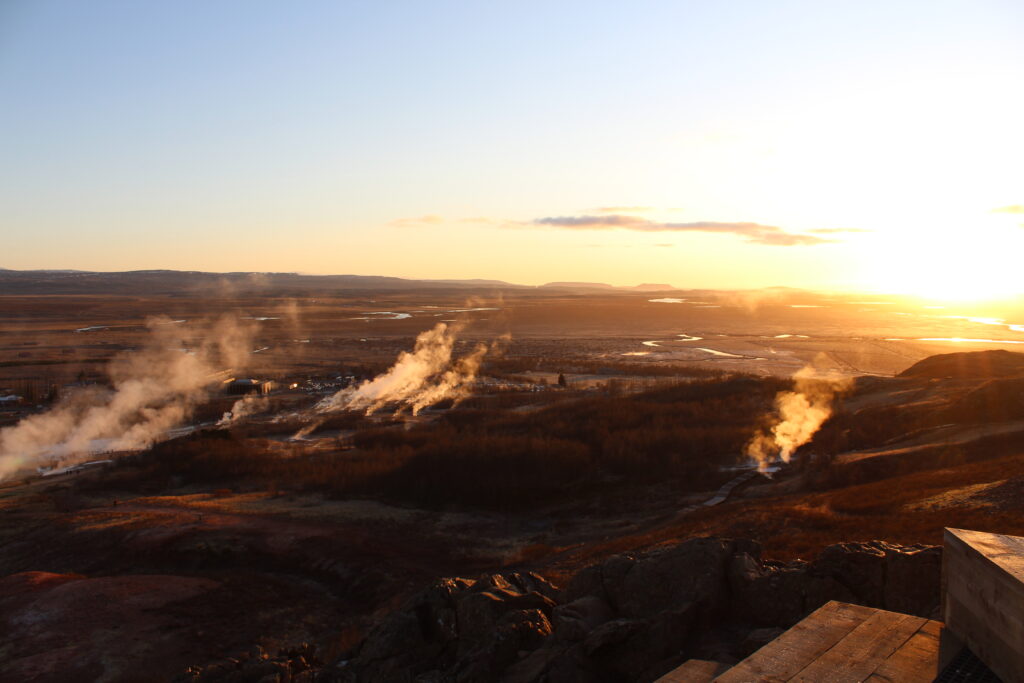
It can get very crowded, so if you prefer some peace and quiet, you can hike up Mt Laugafell and enjoy the view from above.
We drove the Golden Circle on our first day in Iceland and felt quite tired, so we spent most of our time here watching the sun set from Mt Laugafell (at 3.30 pm!!) before heading to the last stop, Gullfoss.
GULLFOSS
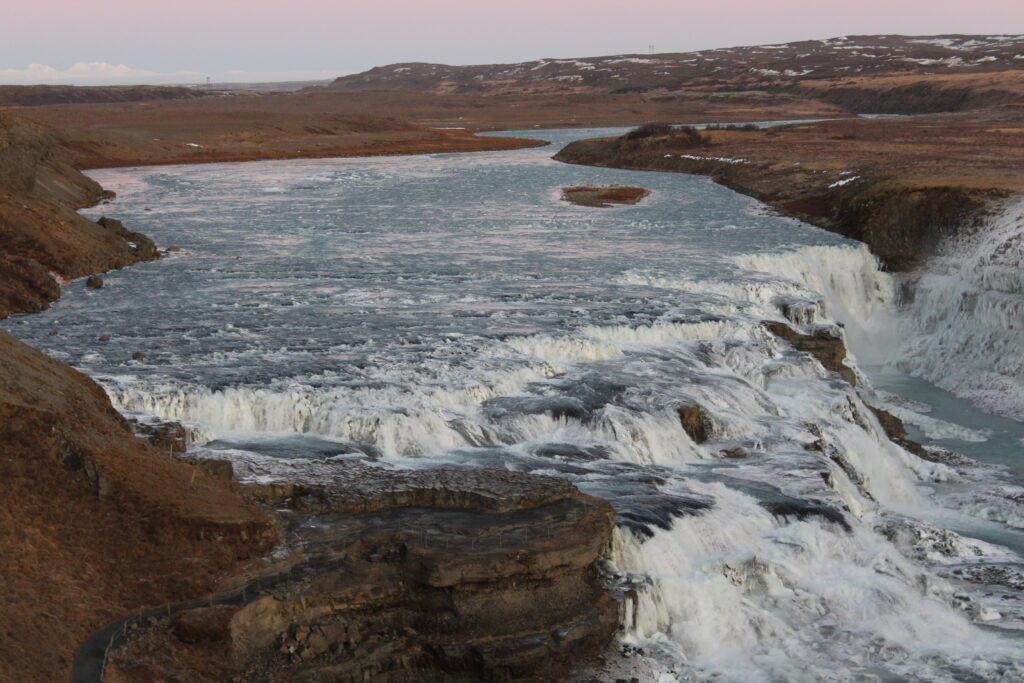
I visited Gullfoss in the middle of winter, and let me tell you I’ve never felt that cold in my entire life! So make sure to dress with lost of layers!
However, it was totally worth it. This was our last stop for the day, as the sun had already set and we didn’t have much daylight left. But it was stunning! We were lucky with the weather, except for the extremely cold wind, and there was a beautiful pink hue in the sky. Plus, it was incredible to see such a powerful waterfall partially frozen. Surely an impressive sight for our first day in Iceland.
The waterfall is very easy to reach, as the carpark is only a couple minutes walk to the viewpoint, up a well marked path.
We only spent 15 minutes here as we were so cold, but we manage to get some spectacular photos before heading off. If by this time you still have time, and daylight, there are a few more stops you can visit on the way back.
SECRET LAGOON
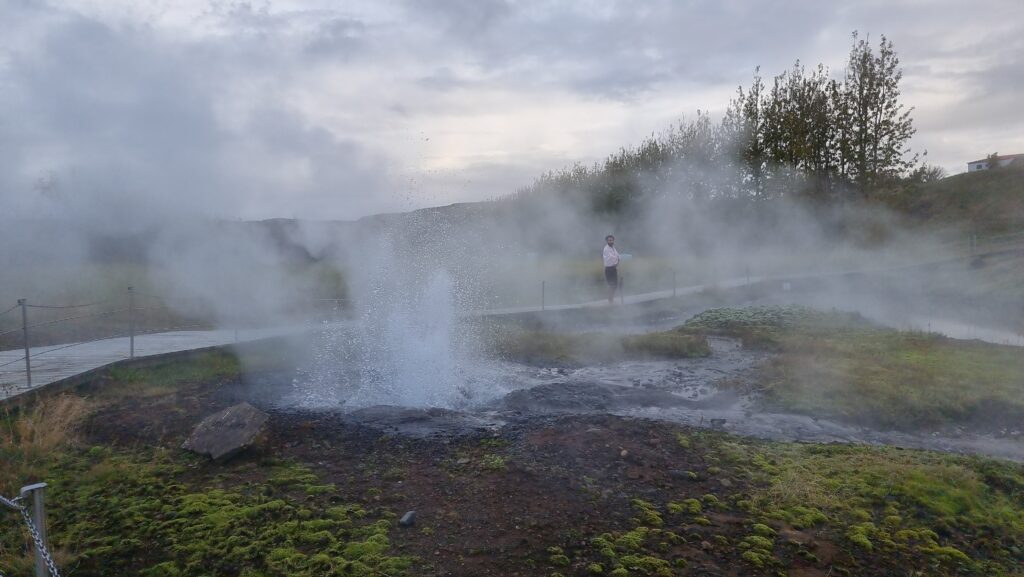
The Secret Lagoon is a man-made pool fed by naturally occurring hot springs. It is the oldest pool in the country, and one of the most popular both for locals and tourists. It was first opened in 1891 and it is simply called gamla laugin (the old pool) by the locals.
Technically it isn’t on the Golden Circle, but it is still on the way back to Reykjavík. From Gullfoss, take route 30 and drive for 30 minutes. This short detour will take you to this little hidden gem.
The Secret Lagoon makes use of its natural terrain and geothermal heating, leaving the water at a temperature of 38-40° Celsius all year long. The area all around the hot spring consists of mossy lava fields and geothermal hot-spots, including a small geyser that erupts every 5 minutes or so, which can be seen from the pool. A wooden platform and a path by the pool allows you to easily explore this area.
The pool is open all year round, 10am to 7pm in winter and 10am to 8pm in summer. It can get quite busy in the summer, so it’s always best to book in advance. Entry fee is 3600 KR (about £20, not including towels).
KERIð CRATER
Kerið is a volcanic crater lake a mere 6,500 years old, which makes it one of the three most recognizable volcanic craters in Iceland, and is made up of a unique red volcanic rock.
The green moss covering the red walls of the crater, together with the deep blue colour of the lake, create a unique and beautiful contrast. Kerið was formed by a cone volcano that erupted and emptied its magma reserve. The weight of the cone then collapsed into the empty magma chamber, creating the current crater.
Today, you can hike down one of the well maintained paths down the crater’s sloping walls and admire this visually stunning geological wonder.
Unlike many attractions in Iceland, there is an entry fee of 600 KR.

